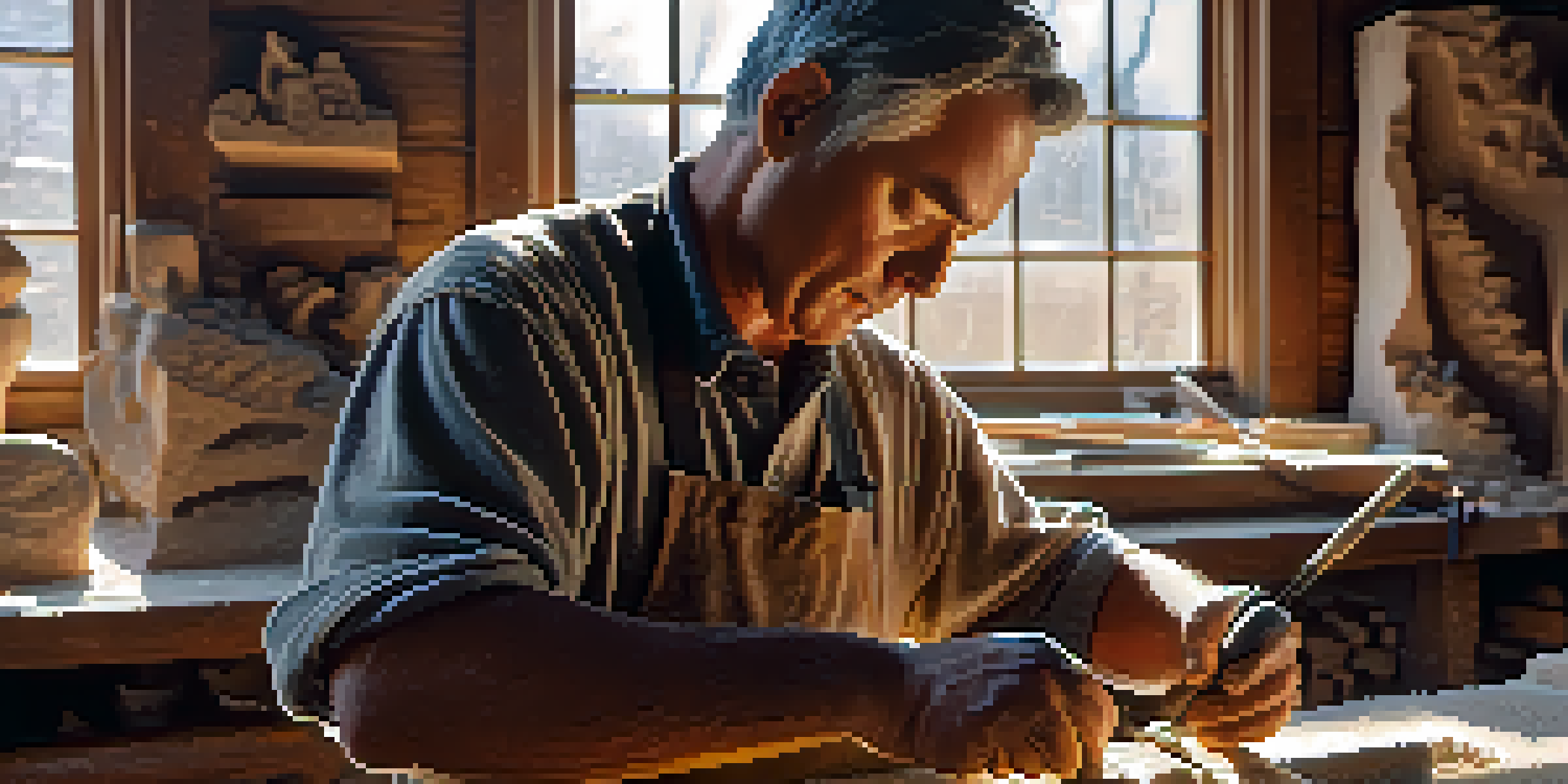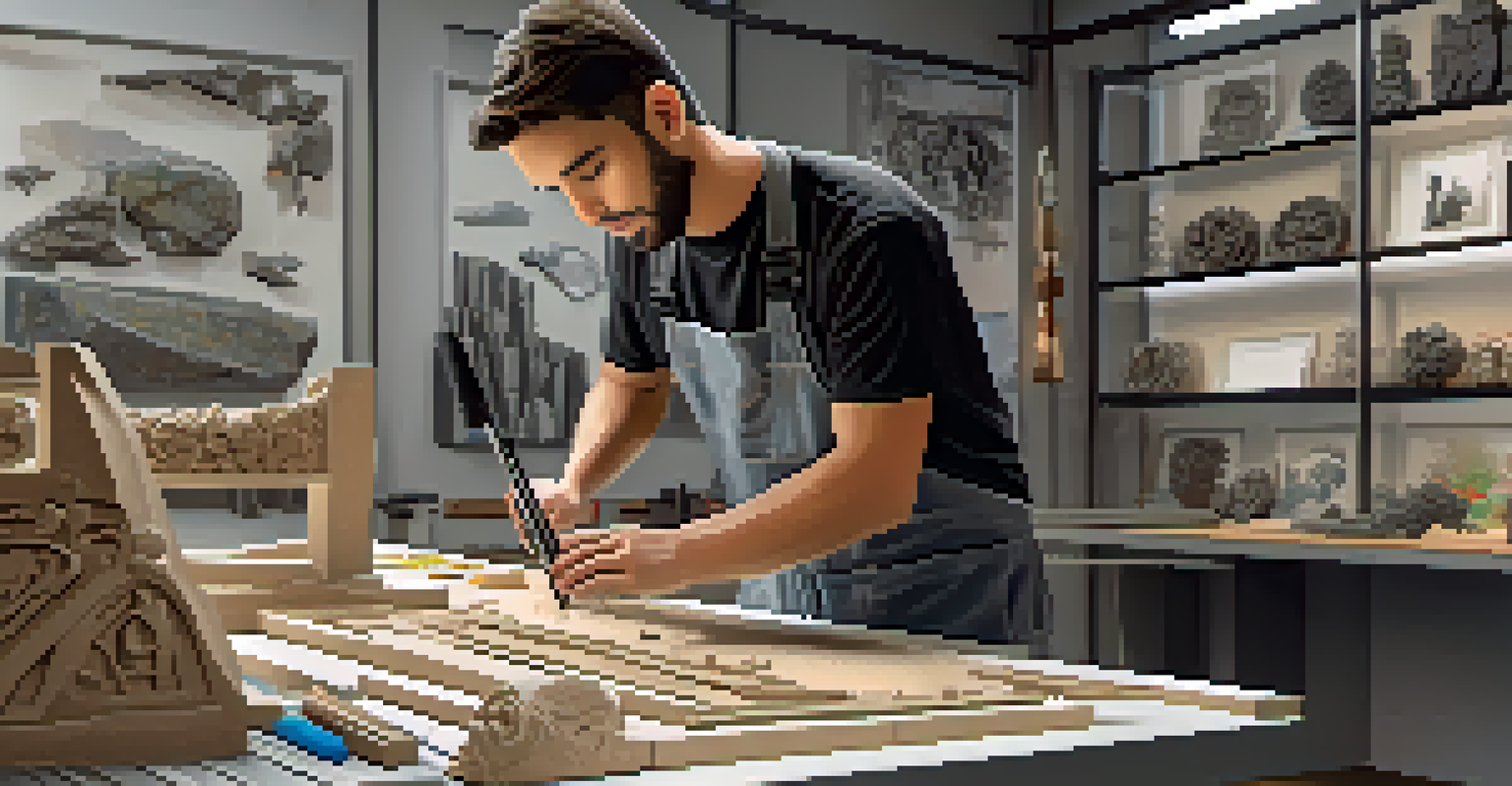The Evolution of Stone Carving Techniques Over Centuries

The Origins of Stone Carving: An Ancient Art Form
Stone carving dates back thousands of years, with early civilizations using simple tools to create functional items and ornate sculptures. The earliest known carvings were made by prehistoric artists, who used rudimentary chisels and hammers to shape stones. These early creations often had spiritual significance, reflecting the beliefs and values of the communities that produced them.
Every stone has a story to tell, and it is the artist's job to listen and bring it to life.
As societies evolved, so did the techniques and tools used in stone carving. For instance, the Egyptians developed more sophisticated tools, enabling them to create intricate hieroglyphs and monumental statues. This period marked a significant leap in artistry, showcasing the skills of craftsmen who dedicated their lives to mastering the craft.
The emergence of various cultures around the world also brought diverse styles and techniques. The Greeks, for example, introduced the concept of proportion and realism, leading to lifelike sculptures that conveyed human emotion. This evolution of techniques laid the groundwork for future advancements in stone carving.
Medieval Advances: From Churches to Cathedrals
During the medieval period, stone carving became a crucial element in the construction of grand cathedrals and churches. Artisans employed new techniques such as relief carving, which allowed for more elaborate designs on facades and interiors. This era saw the rise of Gothic architecture, where intricately carved stone details contributed to the overall splendor of these religious structures.

The use of pointed arches and ribbed vaults in Gothic architecture required skilled stone carvers to create perfectly shaped stones that fit together seamlessly. This precision in carving not only enhanced the aesthetic appeal but also improved the structural integrity of the buildings. Artisans began to focus on craftsmanship, leading to the creation of stunning sculptures that depicted biblical stories and saints.
Evolution of Stone Carving Techniques
Stone carving has evolved from simple tools used by prehistoric artists to advanced machinery and digital technologies that enhance precision and creativity.
Additionally, this period saw the rise of guilds, which organized and trained stone carvers. These guilds preserved knowledge and techniques, ensuring that the art of stone carving continued to flourish. As a result, the medieval era left a lasting legacy in the world of stone carving, influencing generations of artists.
The Renaissance: A New Dawn for Stone Carving
The Renaissance marked a turning point in the history of stone carving, as artists began to embrace humanism and classical ideals. This led to a renewed interest in the study of anatomy and proportion, prompting carvers to create more realistic figures. Famous artists like Michelangelo and Donatello pushed the boundaries of stone carving, producing masterpieces that remain iconic today.
Art is the most beautiful of all lies; it is the expression of our humanity carved in stone.
During this time, advancements in tools and techniques allowed for greater detail and refinement. For example, the introduction of the pointed chisel enabled carvers to achieve intricate textures and delicate features. This period also saw the rise of marble as a preferred medium, with its fine grain providing an excellent canvas for detailed work.
The Renaissance not only celebrated individual artistry but also encouraged collaboration among artists, architects, and patrons. This synergy led to the creation of monumental works, such as the Statue of David and the Pietà, which exemplified the mastery of stone carving. The period firmly established stone carving as a respected art form, setting the stage for future innovations.
Industrial Revolution: Mechanization Meets Tradition
The Industrial Revolution brought significant changes to stone carving, introducing machinery that transformed traditional practices. While hand carving remained prevalent, tools like the stone saw and pneumatic hammer allowed for faster and more efficient cutting. These advancements made stone more accessible and affordable, enabling a broader scope of projects.
Despite the mechanization, many artisans continued to value the intricacies of hand carving. The tension between traditional craftsmanship and industrial efficiency became a defining theme of this era. Many stone carvers sought to blend both approaches, using machines for rough shaping and hand tools for finishing touches.
Cultural Significance of Stone Art
Across the globe, stone carving serves as a vital cultural expression, reflecting local traditions, beliefs, and the historical context of various societies.
This period also saw an increase in the construction of public monuments and buildings, as cities expanded rapidly. Stone carvers played a crucial role in this urban development, creating everything from statues in parks to detailed facades on government buildings. The combination of technology and artistry during the Industrial Revolution reshaped the landscape of stone carving.
Modern Techniques: Digital Tools and Innovation
In recent decades, stone carving has entered a new era marked by digital technology and innovative techniques. Computer-aided design (CAD) software allows artists to create precise models and designs, which can then be translated into stone through CNC (computer numerical control) machines. This technology enables carvers to produce intricate details that were once thought to be impossible.
The use of lasers in stone carving has also gained popularity, offering a level of precision and control that hand tools cannot match. Lasers can cut and engrave complex patterns, making it easier for artists to experiment with new styles and ideas. This fusion of traditional methods with modern technology has expanded the creative possibilities for stone carvers.
However, many contemporary artists still embrace the tactile nature of hand carving, recognizing its unique qualities. This blend of old and new techniques showcases the versatility of stone as an artistic medium. As the industry continues to evolve, stone carving remains a vibrant and dynamic art form that honors its rich history.
Cultural Significance: Stone Carving Around the World
Stone carving is not just a technical skill; it's a cultural expression found in diverse societies across the globe. Each culture has its unique style and purpose for stone carving, reflecting local traditions, beliefs, and aesthetics. For instance, Native American stone carvings often depict spiritual symbols and animals, while Indian artisans create intricate temple sculptures that tell stories from mythology.
In many cultures, stone carving holds historical significance, serving as a record of societal values and technological advancements. The craftsmanship involved in these carvings is often passed down through generations, preserving cultural identity and heritage. This connection to history makes stone carving a vital aspect of cultural expression.
Future Trends in Sustainability
The future of stone carving is increasingly focused on sustainability, with artists exploring eco-friendly practices and innovative materials to minimize environmental impact.
Moreover, contemporary stone carvers often draw inspiration from their cultural backgrounds, blending traditional techniques with modern themes. This dialogue between past and present enriches the art form, making it relevant in today's world. As globalization continues to shape artistic practices, stone carving remains a powerful medium for storytelling and cultural representation.
Future Trends: Sustainability and New Materials
As we look to the future, sustainability is becoming a key focus in the world of stone carving. Artists and industries are increasingly aware of the environmental impact of quarrying and stone production. Many are exploring eco-friendly practices, such as sourcing stone from sustainable quarries or utilizing recycled materials in their work.
Additionally, innovations in materials are opening up new avenues for stone carving. For example, composite stones made from natural aggregates and resins offer similar aesthetics to traditional stone while being lighter and more versatile. These materials expand the possibilities for artists, allowing for greater experimentation and creativity.

The future of stone carving may also see a greater integration of technology, with advancements in 3D printing and virtual reality further transforming the craft. As artists continue to push boundaries and embrace new ideas, stone carving will undoubtedly evolve, reflecting contemporary values and artistic expression while honoring its rich heritage.